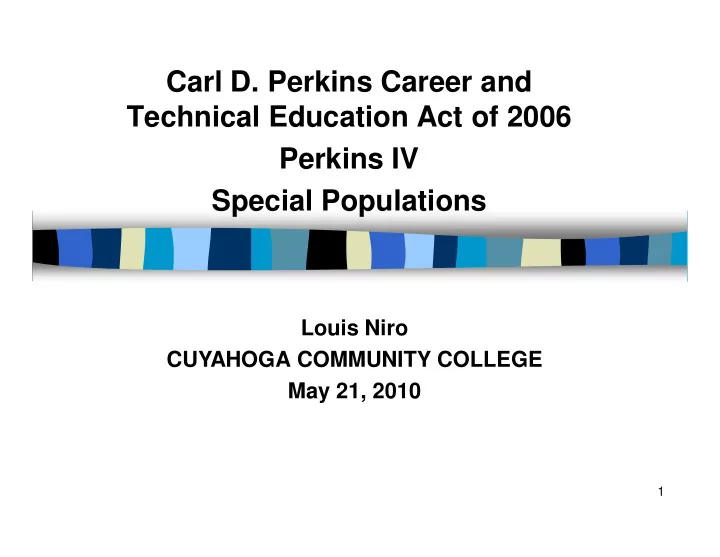

Carl D. Perkins Career and Technical Education Act of 2006 Perkins IV Special Populations Louis Niro CUYAHOGA COMMUNITY COLLEGE May 21, 2010 1
Special Populations… � 1. Overview/Purpose � 2. Discussion of special population defined by the Carl D. Perkins Act of 2006 � 3. Reporting Basics � 5. Implications � 6. Q& A 2
Performance Indicators • Technical skill attainment – 1P1 • Credential, Certificate or Degree- 2P1 • Student Retention or Transfer – 3P1 • Student Placement -4P1 • Non-traditional Participation-5P1 • Non-traditional Completion – 5P2 3
Purpose for Special Populations? � To assure accountability for services to special populations, � To ensure that special populations students benefit from vocational education and the support services; and � To have an increased awareness of the implications and importance of reporting 4
What are Special Populations? Special populations, as defined by Perkins are: � Individuals with disabilities � Individuals from economically disadvantaged families, including foster children � Individuals preparing for nontraditional training � Single parents, including single pregnant women � Displace homemakers; and � Individuals with limited English proficiency . 5
How Needs of Special Pops Assessed? � Nine Mandated Activities. Under Section 135 (b) of Perkins IV � (9) Provide Activities to Prepare Special Populations, including Single Parents and Displaced Homemakers who are Enrolled in Career and Technical Education Programs, for High Skill, High Wage, or High Demand Occupations that will lead to Self Sufficiency . � Various Services are available to eligible students: Assessment conducted to determine support services required, academic/career counseling, tutoring, accommodations, etc… 6
Why Collect Data & Report It? � 1 . ED (Dept. of Education) – Law(Perkins Act) – State Plan (Ohio) – EDGAR – Perkins IV Monitoring Guide � 2. Institution Plan � 3. Institution/Agency � 4. Professional � 5. Reporting for Advocacy � 6. Site Visits/Audits 7
BENEFITS for OHIO….. Broader Implications for Serving Special Populations: Broader reasons for ensuring that special population students benefit from vocational education. • The magnitude of individuals representing special populations in Ohio makes it imperative that their needs be addressed. 1. The Americans with Disabilities Act (ADA) serves a large # of Ohioans. The majority of students with disabilities are enrolled in Community Colleges; 2. A large # of Limited English Proficient (LEP) are enrolled in Community Colleges; 3. Women dominate the poverty statistics. Fifty-four percent of poor families are maintained by women alone, the majority of whom are single parents or 8 displaced homemakers;
4. Women today earn on average 75% of the wages of men. If they were employed in a broader range of occupations, i.e. occupations nontraditional for their gender, their economic status would improve. 5. Individuals in special population categories are most likely to be left out of economic rewards. They often experience barriers to receiving training and entering into the workforce. 6. To ensure that all Americans have access to bright economic futures, these barriers must be addressed and special population students must be given state of the art training. It is simply the right thing to do. • Our nation's economy depends on a well-trained and growing work force. We cannot afford to leave 9 special populations out of the work force.
Cuyahoga Community College Data for 2008-09 Out of a Total (Fall 08) enrollment of 26,048, the Special Populations students represented are: 1,640 4.3% Individuals with Disabilities Economically 11,890 31.0% Disadvantaged Nontraditional Enrollees 629 1.6 % Single Parents 318 .8 % Displaced Homemakers 123 .3% Limited English Proficient 1,015 2.6% 10
Access Program 2008-09 Cuyahoga Community College Disability Number Percent Deaf/Hard of Hearing 66 4% Visual 39 2.3% Speech 3 .1% Mobility 63 3.8% Traumatic Brain Injury 26 1.6% Specific Learning Disabilities 678 41% Attention Deficit Disorder/Hyperactivity 143 8.7% Autism/Asperger Syndrome 14 .8% Cognitive/Intellectual 110 6.7% Health/Chronic 104 6.3% Psychological/Psychiatric 323 19% Other 72 4.3% Total 1,641 100% 11 Source: Access database and Banner Student system
Provision of Services for Special Populations • Given the large numbers of students from special populations enrolled in Ohio Community colleges CTE programs, it is abundantly clear that Ohio's economic future relies on the successful performance of its special populations students. • Furthermore, at the community college, Perkins dollar allocations are based on the number of economically disadvantaged students served by the institution. • Best of Luck in administering your Grants! • Questions? • Thank You 12
Recommend
More recommend